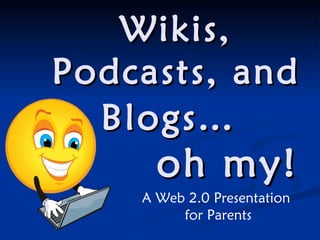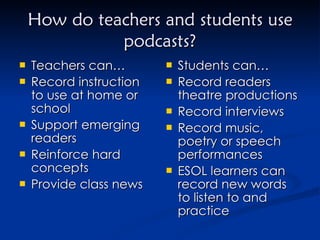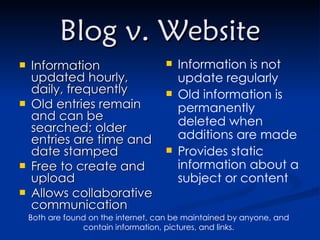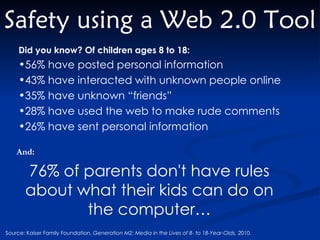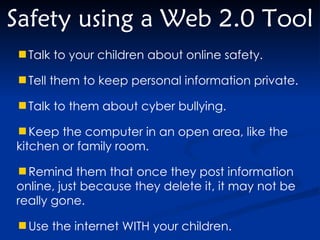Wikis, podcasts, and blogs
- 1. Wikis, Podcasts, and Blogs… oh my! A Web 2.0 Presentation for Parents
- 2. What is a Wiki? Wikiwiki = quick or fast in Hawiian A wiki is an editable online document that can be edited at anytime by anyone registered to use the wiki. For a simple explanation video on wikis, click here .
- 3. How are wikis used in the classroom? Collaboration and communication Research (finding reliable and relevant information) Critical Thinking Editing and revising Encourage students to be creators of knowledge Using a wiki with students helps to address the following skills:
- 4. Teachers and students can use a wiki to discuss and share research, discuss and review literature, or edit and revise their writing. Wikis can be used school-wide (staff, students, and parents) to share school happenings. How are wikis used in the classroom?
- 5. Wiki vs. “Regular” Website Source: www.ewriteonline.com Require permission to publish Mediated by experts Transactional Governed by workflow or publishing cycle Graphic design conveys content organization to user Staffed by professionals with a range of skills: designers, developers, content types Judged by outcomes Relevant Useful Correct Alive Updated regularly Read Authored collaboratively Little to no graphic design Foster dialogue or conversation Socially mediated Content author in charge of content over time Web Sites Shared Traits Wikis
- 6. What is a podcast? A podcast is a series of digital media files (audio, video, etc.) that can be downloaded to an MP3 player or other mobile device. A podcast can also be broadcast on the Internet much like a radio broadcast. For a simple explanation video on podcasts, click here .
- 7. How are podcasts used in the classroom? Increase fluency To publish writings and other research Promote books Share information from distant resources Learn a new language Practice new words
- 8. What safety issues are involved? Be aware of who is producing the podcast Try to discern their motive or reason for sharing the information As with any website know that there could be some bias depending on who is sharing the information and their purpose for sharing.
- 9. When is a podcast useful? When you want an alternate way to share information When you want the the information to be portable When hearing the information is better or more desirable than seeing the information
- 10. Podcast v. Website Downloadable so no need for Internet access Can listen on your phone, MP3 player or other portable device Free to create and upload Great for auditory learners Must have Internet access Need a computer to access Fees to host a website Great for visual learners
- 11. How do teachers and students use podcasts? Teachers can… Record instruction to use at home or school Support emerging readers Reinforce hard concepts Provide class news Students can… Record readers theatre productions Record interviews Record music, poetry or speech performances ESOL learners can record new words to listen to and practice
- 12. And then… Teachers and students can download the information and take it with them wherever they go!
- 13. What is a blog? A blog (sometimes referred to as a weblog) is a Web publishing tool that allows authors to quickly and easily self-publish text, artwork, links to other blogs or Web sites, and a variety of other content. Postings are often short and frequently updated. They appear in reverse chronological order and can include archived entries. For a simple explanation video on blogs, click here .
- 14. Educational Benefits of Blogs Blogs are: Highly motivating to students, especially those who might not become participants in the classroom. Excellent opportunities for students to read and write. Effective forums for collaboration and discussion. Powerful tools to enable scaffolded learning or mentoring to occur.
- 15. Blog v. Website Information updated hourly, daily, frequently Old entries remain and can be searched; older entries are time and date stamped Free to create and upload Allows collaborative communication Information is not update regularly Old information is permanently deleted when additions are made Provides static information about a subject or content Both are found on the internet, can be maintained by anyone, and contain information, pictures, and links.
- 16. How are Blogs used in the classroom? Student Portfolios Blogs present, organize, and protect student work as digital portfolios. As older entries are archived. Teachers and peers may conference with a student individually on a developing work. Discussions A class blog opens the opportunity for students to discuss topics outside of the classroom. Students have time to be reactive to one another and reflective. Collaboration Blogs provide a space where teachers and students can work to further develop writing or other skills with the advantage of an instant audience. Teachers can offer instructional tips, and students can practice and benefit from peer review. Students can also participate in cooperative learning activities that require them to relay research findings, ideas, or suggestions. Classroom Management Class blogs can serve as a portal to foster a community of learners. They are easy to create and update efficiently, they can be used to inform students of class requirements, post handouts, notices, and homework assignments, or act as a question and answer board
- 17. Safety using a Web 2.0 Tool Did you know? Of children ages 8 to 18: 56% have posted personal information 43% have interacted with unknown people online 35% have unknown “friends” 28% have used the web to make rude comments 26% have sent personal information And: 76% of parents don't have rules about what their kids can do on the computer… Source: Kaiser Family Foundation, Generation M2: Media in the Lives of 8- to 18-Year-Olds, 2010.
- 18. Safety using a Web 2.0 Tool Talk to your children about online safety. Tell them to keep personal information private. Talk to them about cyber bullying. Keep the computer in an open area, like the kitchen or family room. Remind them that once they post information online, just because they delete it, it may not be really gone. Use the internet WITH your children.
- 19. Bottom line… Web 2.0 tools are a free, easy way to share and create information on topics you are interested in. They can fit your needs. Easy to access, sometimes portable and kid-friendly. These tools provide authentic learning experiences for all users.
